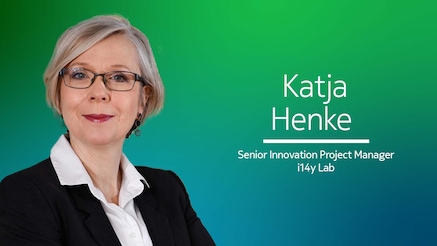Open collaboration to the test
Real Conversations podcast | S5 E2 | January 17, 2023

Biography
Open ecosystem evangelist, Katja Henke is the Senior Innovation Project Manager Technology at i14Y Lab, an open network and collaboration facility led by Deutsche Telekom working to accelerate network aggregation and Open RAN.
No single CSP (communication service provider), vendor, or SME (Small Mid-size Enterprise) can go it alone in the age of wireless disaggregation. The i14y Lab in Berlin is bringing the wireless community together to accelerate the development of 5G and next generation hardware and software. The lab's Senior Innovation Project Manager, Katja Henke, explains the three-year mandate of the lab and what it will accomplish.
Below is a transcript of this podcast. Some parts have been edited for clarity.
Michael Hainsworth: Deep in the heart of Berlin beats the i14y Lab. Its purpose? Bring the wireless community together to accelerate the development of 5G and next generation wireless hardware and software because no single vendor, CSP or SME, can go it alone in the age of disaggregation. Cooperation is critical to success. Nobody knows that quite like Katja Henke, the Senior Innovation Project Manager at i14y. My first question: what does i14y mean?
Katja Henke: That is a good question and I've been asked that quite often. i14y stands for interoperability and if you have the I and the 14 and you leave out the characters in between, then you will count 14. So i14y interoperability, so it's faster, more efficient and that's the solution.
MH: Interoperability is critical when we talk about the type of infrastructure that you're working on.
KH: Yes. Actually, we have talked a lot in the last few years about disaggregation, network disaggregation, and that means opening up this form of black box system, especially in the area, for example, of radio access networks. And that is exactly the point. If you open up the black box and also invite more players to come up with solutions, you also need to make sure that the interoperability between these different systems is working.
MH: You've written that there was a time when a solo inventor could change the world, but I can imagine disaggregation of the network comes with integration and interoperability challenges. Since 5G is being deployed using multiple vendors within a given CSP, it's all about that interoperability. It's about collaboration, that's crucial for everyone to succeed.
KH: Exactly. As I mentioned, disaggregation is a point where you really open up this black box system and it is important that the people then here really collaborate to develop these new solutions. It cannot be done by one company anymore because it requires so many skills and it is also not only time consuming, but also very investment consuming. And it is especially important to bring all these players together. I think collaboration is key. That is why we think that the community approach and ecosystem is really important to drive that forward. For example, all these lineups approach and when it comes to openness, it means that more people come together and more players, so that is important.
MH: So, who's on board?
KH: There are three operators. That means Deutsche Telekom, Telefónica and Vodafone. And then we have all the three vendors, three small and medium enterprises and two academic institutions. And everything is then funded partially by the German Ministry for Digital and Transport. And I can go into more detail about the different groups if you like.
MH: Let's work our way up from that list of the operators, the vendors, the SMEs and the academic institutions. But you also said that this is because of the German Ministry for Digital and Transport. Let's talk about why they got involved in the first place to bring all the rest of you together.
KH: It is important not only for Germany, I would say for Europe as well, but here, the German Ministry for Digital and Transport has decided to foster and really trigger this ecosystem building. And for this initial start, it really needs to fund different activities. For example, to set up such an open lab as we run here in Berlin, but also further calls will follow, for example, also how to foster SMEs in this field so that they feel attracted to working on network disaggregation in general. I would say it is in their interest to go really step by step to foster the whole development.
MH: And so, the three operators, Deutsche Telekom, Telefónica, Vodafone, what is their role in all of this?
KH: First of all, it is always important that the vendors and all the players who come along to build such an ecosystem work closely together. They need to understand what the operator's requirements are. And here with the open lab, we provide a touchpoint with three of these operators so that they better understand our way of working and our requirements. And we want to give access to reference implementations which we have agreed among us. And our ultimate goal is also to avoid fragmentation, where it's always a risk when you have different ecosystems in place. As we agree on these test scenarios, then there is more certainty for the vendors, which is really our pain-point.
MH: And as far as those vendors are concerned, I know you've got Rohde & Schwarz, Capgemini Engineering and Nokia What is their role in all of this?
KH: They contribute to developing reference implementations. For example, they also provide test equipment. But as I said, this is a consortium, so that means that they build some parts of it, but we also collaborate further with other vendors to complement the environment. They also bring their experience not only in the form of equipment, but also skill sets and expertise into play.
MH: That expertise is folded into academic institutions like TU Berlin and Fraunhofer. But also, I think for SMEs, this is the critical point to this. I see the Open Radio Access Network as the linchpin here. If small companies can't afford to build out their contributions to O-RAN, this is where they can go, they can test their technology capabilities to work with larger vendors?
KH: I would not only trust it's the smaller companies, I think such a test environment is also important for the bigger vendors because they have an interest to get certified, to get the badges. But of course, it makes sense, especially for the smaller ones who cannot afford to set up such an infrastructure or to get access to such an infrastructure. They, of course, have a specific interest, but really to make clear, it is important to the broader ecosystem here as well, also to the bigger players, and especially as it is also to reduce the transaction cost for everyone, especially as it is our intention to share results so that everyone can benefit from that.
MH: And I guess that's why you've got PlugFest. We should probably explain what PlugFest is.
KH: Yes. PlugFest, is, of course, not a type of party or anything like that. It is more where different vendors come together and it could be hardware and software. And before they start the PlugFest, they agree on a test plan and what should be tested and then they come to a certain timeframe together also. Let's also say, as we currently have a PlugFest running for two weeks, and they test their equipment against each other or their software and it can happen onsite, but it could also be done remotely. They really come together to test and furthermore to get more inputs for developing further blueprints and standards so to accelerate market readiness in the future.
MH: Tell me about how you're building this open lab in Berlin to help build that future of telco networks. You're testing and validating components for their interoperability and integration?
KH: Yes, not only for the interoperability into integration, I would also say for the conformance in general. It is very important that we provide access here also for permanent testing because it's not only once a year to run a PlugFest, but also really a continuous development. We also need to run these permanent test and certification processes and to really set here a broader frame for standardized testing in general based on shared scenarios. And this is really to build the open ecosystem further.
MH: Since you're in the early stages of setting up this lab, how will the partners collaborate beyond things such as PlugFest?
KH: I would say there are different possibilities. First of all, there are those companies who have an interest in testing or validating, be it their hardware, the software, so they can come along to run the test, to specify the test, to get certified or batch together with the O-RAN Alliance specifications and the TIP. But also, as we have been at Fuze [a startup event], many companies also reached out to us with the interest to become an associated partner of the open lab. And here we are in general open, but of course we need to go step by step to onboard them. But you see, we are at the beginning and will grow step by step.
MH: Tell me about those steps. What's the next step for you?
KH: The lab is operative but still growing. We need to work more to define the test cases and to develop blueprints. We also think about, or not only think about, but we also want to start with this permanent testing at the beginning of next year. It is really to go step by step and improve our processes. It's especially about how to automate these processes even further and also to see different activities. What we have learned is that events are also very important, really important to bring the community together. It's not only a PlugFest, which might take place once a year, there could also be smaller meetups also to organize exchanges among the different players. I think that is important and we will work on that as well. What we have also identified is that upskilling is a very important activity and here, we will also start thinking about how to do that, how to foster doing that in collaboration with other partners.
MH: Tell me more about that upskilling component because there is an understanding that we are entering a whole new way of approaching wireless networks with 5G and then 6G and everything beyond that. What's the current state of education within the industry that needs those skills to be leveled up?
KH: Okay, it would be really hard to go into all the details, but I think what is observable, is that, of course, Radio Access Network development, disaggregation, open radio networks require new resources. And what we see within telcos or also other companies, it does not exist to the full extent, so people have to learn, as it is always the case when you come up with new approaches. But it is really required to do that and also to provide a possibility not only for us here at the lab, but also to do that for others.
MH: Let's expand upon that because, as you mentioned, there are two academic institutions that are on board as well. Tell me about who they are and what role they'll provide in the lab.
KH: On the one hand, it is from Fraunhofer Institute, the Fraunhofer HHI Institute, and on the other hand, it is the technical university. Here, they are in charge of working on security testing and security is one important topic when it comes also to disaggregation and the other part is how to develop an innovation environment for testing. Also, for example, digital twin approaches. So, it goes in this direction. And it's really how to prepare the pipeline for further developments in the lab.
MH: Tell me about those three SMEs.
KH: Yes. We are very happy to have them on board. All three of them are based in Berlin, so just around the corner from the i14y Lab. And here, we have EMTC. They have been around in the market for testing for 20 years. They bring a lot of expertise in the field of testing. And also, the BISDN is very much in the automation of the lab and how to do that. And then we have pricing technologies. So, they come from open-source software development for assembly. And it is really good to have these smaller companies that have been in the market for a long time and to complement the requirements here and the knowledge of operators, especially to set the lab up.
MH: This all feels very much like a startup. Let's talk about those deliverables. You've got a three-year mandate and I can imagine you'd like to keep going after the three years of funding.
KH: Definitely. I mean that would be our goal. And the first year has almost passed and two years to follow. But what we have understood is that it is important to already start thinking about how to continue. That is our goal, to think about how to provide these services, these offerings also after the funding and that is why we have set up a stream thinking about a future model, whom to involve, how to do that and that is very much also the startup effect. I cannot say what it will look like, but definitely it is really an endeavor and, especially with all these consortium partners on board, it will keep us busy.


